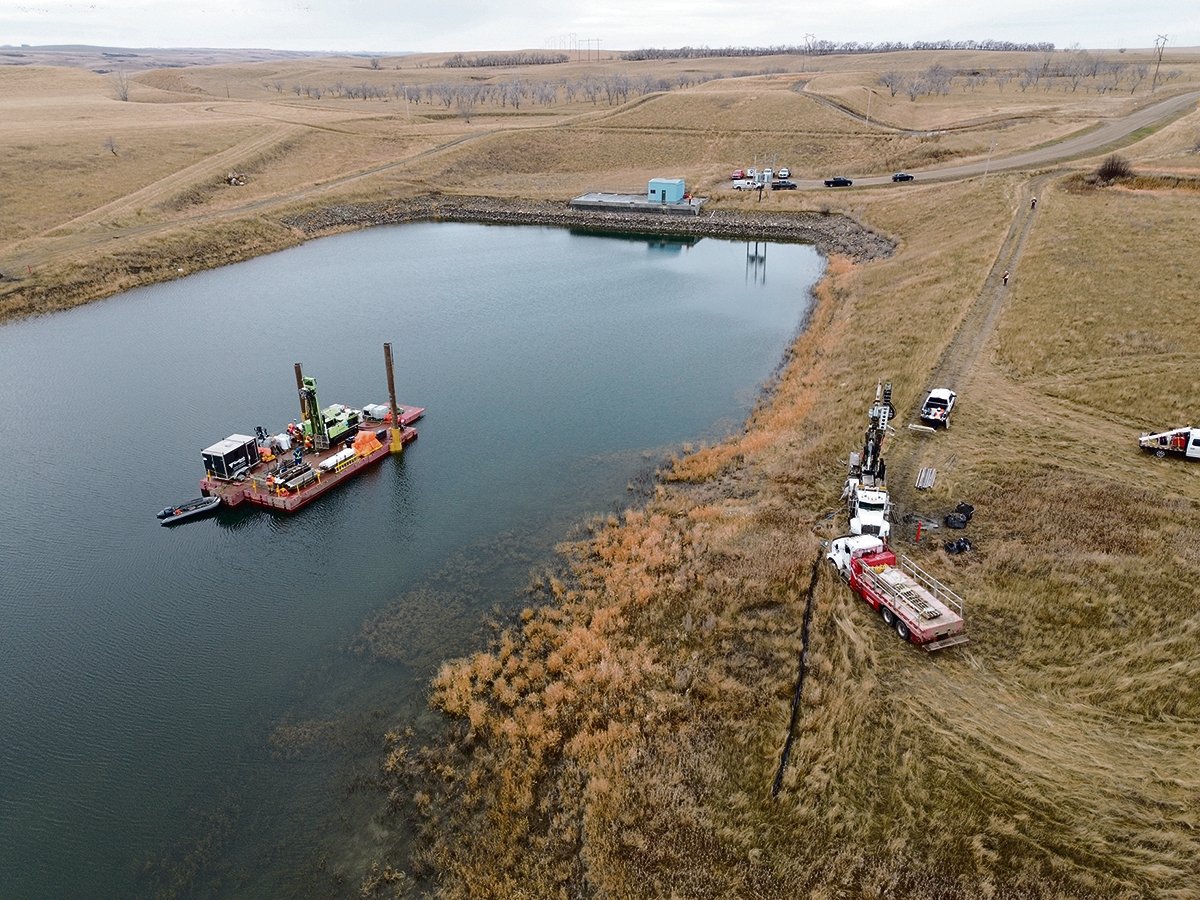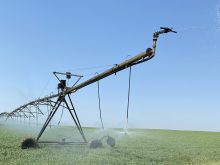Fall field work last year contributed to the Sask. project’s assessment process ahead of construction planned for 2026
OUTLOOK, Sask. — A barge working in Coteau Bay on Lake Diefenbaker this fall was an essential part of the preliminary work on the Westside Irrigation Rehabilitation Project.
The barge was used to drill 40-metre-deep boreholes to collect soil samples near the Westside pump station.
The information will help engineers establish the capability of the intake structure, said Jamie Kunz, an engineer at MPE and part of the Prairie Engineering Partners team working on the first phase of the Lake Diefenbaker megaproject.
Read Also

Drones now used to assess wildlife crop damage in Saskatchewan
Wildlife damage in Saskatchewan crops is now assessed by drones and artificial intelligence.
The team is a joint venture of MPE and Stantec, which were hired last July to do the 60 per cent design of the WIRP.
Kunz told a workshop that more than 100 people are working “to facilitate a very aggressive and large scope of work in a relatively short period of time.”
The provincial government announced in March 2024 it would go ahead with construction of the first 90,000 acres of the larger project it proposed in 2020. Construction is likely to start in 2026.
The rehabilitation project is first because much of the infrastructure had been built about 50 years ago.
“We’re really working to maximize and to optimize the existing infrastructure that’s there, so the existing pump station, the existing canal, developing out Conquest reservoir and then developing distribution systems for that,” said Kunz.
The field work includes environmental services, engagement with stakeholders, including Indigenous people, and a huge geotechnical project, he said.
Kunz said the Westside pump structure is at the heart of it all.
“Some past assessments have been done on that structure, and it’s been determined that the structure itself can handle close to 30 (cubic metres per second), and so that correlates out to how we’re getting to that 90,000-acre development,” he said.
However, the existing canal can’t support that flow, and the Conquest reservoir still requires geotechnical work to establish what it can handle, he said.
The distribution systems off the entire system also have to be determined.
Kunz said estimating the cost is a major component before all the pieces can be put in place.
“We’re basing most of the design decisions on what’s best value to the project,” he said.
The government has said it will cost about $1.15 billion, but a portion of that will be shared with landowners who want to irrigate.
Through the fall, drill trucks were working on the canal and reservoir. Soil sampling was also done on about 10,000 acres for this part of the project.
At the pump station, in addition to the barge, divers looked at the intake structure to determine its condition, and assessment reports are in the works, Kunz said.
In addition to canal upgrades, he said some structures and crossings won’t be able to handle the flow.
“We want to go out and do condition assessments, and potentially rehabilitation, on those pieces of infrastructure,” he said.
At the same time, the province’s Water Security Agency is investigating future irrigation potential.
Joel Peru, director of irrigation development, said Lake Diefenbaker was originally designed to support 500,000 acres of flood irrigation.
“Flood irrigation uses about twice the allocation of what modern centre pivot irrigation is,” he noted.
WSA is working with a consultant to guide future irrigation development while maintaining recreation, cottage owner expectations and other uses.
The study area is approximately one million acres in a 10-kilometre buffer around the entire lake.
Peru said one possibility is to look at places where larger infrastructure could serve more producers and land. This would reduce the number of intakes in the lake while still providing water.

The study identified exclusion zones, such as already established irrigation districts, parks, protected areas, pastures and protected wildlife habitat lands.
It also considered existing value-added processing, including potato sheds, intensive livestock and seed processing within the zone.
Peru said the study is looking at soil quality, because not all soils are irrigable, as well as topography, current land use, wetlands, railroads and more as it whittles down the possibilities.
Any proposed development will have to go through the irrigation certification process to verify the desktop information, he said. Soils are rated from Class 1, the best, to Class 5.
“As an example, we recently did this exercise around the SSEWS (Saskatoon South East Water Supply System), where we found there that even some of the Class 4 land is still possible to irrigate in certain circumstances, if proper improvements are in place, such as installing subsurface drainage,” Peru said.
Obviously, pumping costs are cheaper in flatter areas. He said the study considered the maximum economic threshold for a pump station to be between 100 and 130 metres.
Peru said after the study is complete, it will make available conceptual engineering plans, pipeline distribution, pump size and type, and some other factors, as well as a final cost estimate.
Stakeholders will then be consulted on whether they want to be involved in a large-scale common project.
So far, the study identified 340,000 acres adjacent to the lake where infrastructure such as a canal wouldn’t have to be added. Thirty potential pump site locations, based on topography, were also identified.
Meanwhile, a group of about a dozen producers have brought forward a proposal under East Elbow Irrigation. Peru said it’s an expansion area that has been heavily studied since the 1980s.
The producers worked with the agriculture ministry on soil suitability for a project of up to 30,000 acres and are now working on conceptual engineering to determine feasibility.
“We want to see producers drive these projects with government having more of a supportive role. We know from experience that the projects driven by producers themselves are much more likely to succeed,” Peru said.
There are currently 22 irrigation districts in Saskatchewan, but the bulk of irrigation is done by private irrigators.
















